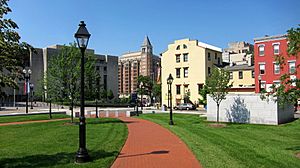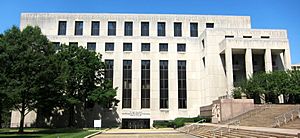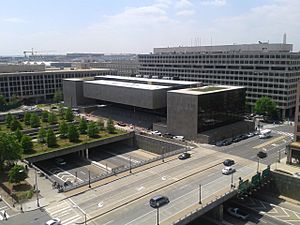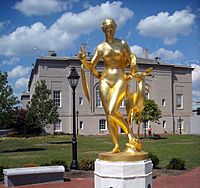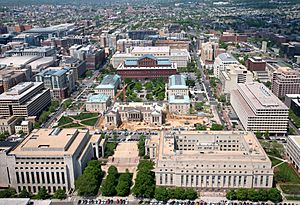Judiciary Square, Washington, D.C. facts for kids
Quick facts for kids
Judiciary Square
|
|
|---|---|
|
Neighborhood of Washington, D.C.
|
|
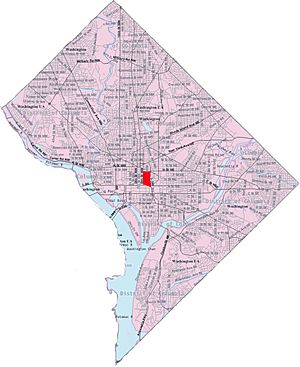
Map of Washington, D.C., with Judiciary Square highlighted in red
|
|
| Country | United States |
| District | Washington, D.C. |
| Ward | Ward 6 |
Judiciary Square is a cool neighborhood in Northwest Washington, D.C.. It's mostly filled with important buildings like courthouses and government offices. You can find Judiciary Square between Pennsylvania Avenue to the south and H Street to the north. It's also near 6th Street to the west and the Interstate 395 tunnel to the east.
Right in the middle of the neighborhood is a public space also called Judiciary Square. This square is bordered by 4th Street, 5th Street, D Street, and F Street. Getting there is easy because the Judiciary Square station on the Red Line of the Washington Metro serves the area. You'll also find Georgetown University Law Center here, which is a big law school.
Contents
A Look Back: History of Judiciary Square
In the early 1800s, Judiciary Square was a busy place where many people lived. Because it was so close to the courthouses, lots of lawyers, judges, and clerks chose to live here. It was also a great spot for government workers since it was located between the White House and the United States Capitol. Some famous people who lived here included Senator Thomas Hart Benton, Vice President John C. Calhoun, and Daniel Webster. Today, most of those old houses are gone, with just a few remaining near 5th and D Streets.
The Italian Community in Judiciary Square
Around the year 1900, the eastern part of Judiciary Square became a special place for Italian immigrants in Washington. It was like a "Little Italy" even though it wasn't officially called that. This Italian neighborhood stretched from the square eastward to about 2nd Street NW. The heart of this community was the Holy Rosary Church, which was built at 3rd and F Streets NW.
The Italian community grew throughout the 20th century, with many new immigrants arriving in the 1950s and 60s. However, in the 1970s, a big highway called Interstate 395 was built through the city. This construction destroyed about half of the neighborhood. It also forced many residents to move away because of all the traffic. Today, this area is mostly filled with government and law offices. But the Holy Rosary Church is still there. It continues to be a gathering place for Italian families and has a cultural center called "Casa Italiana" next door.
Important Buildings You Can Find Here
Judiciary Square is home to many important buildings. These include local, state, and federal offices.
District and Local Government Buildings
- H. Carl Moultrie Courthouse: This building houses the Superior Court of the District of Columbia. This is where local trials happen.
- District of Columbia City Hall: This building is now home to the District of Columbia Court of Appeals. This is the highest court in the District.
- Henry J. Daly Building: This is the main headquarters for the Metropolitan Police Department of the District of Columbia.
- Jackson Graham Building: This building is the headquarters for the Washington Metropolitan Area Transit Authority, which runs the Metro trains and buses.
United States Federal Buildings
- E. Barrett Prettyman United States Courthouse: This large building holds two important courts: the United States District Court for the District of Columbia and the United States Court of Appeals for the District of Columbia Circuit.
- United States Court of Appeals for Veterans Claims: This court handles cases for military veterans.
- United States Tax Court Building: This building is where the United States Tax Court is located.
- United States Court of Military Appeals building: This building houses the United States Court of Appeals for the Armed Forces.
- Federal Bureau of Investigation Washington field office: This is a local office for the FBI.
- Frances Perkins Building: This building is home to the United States Department of Labor.
- US General Accounting Office Building: This building houses the headquarters of the Government Accountability Office and the United States Army Corps of Engineers.
Other Notable Buildings
- One Judiciary Square: This is a modern glass building with various D.C. government offices. It even temporarily housed the Mayor's office and the City Council from 1992 to 1999 while another building was being fixed.
- Steve Young Law Enforcement Legislative Advocacy Center: This center belongs to the Fraternal Order of Police.
- National Building Museum: This museum, once known as the Pension Building, is dedicated to architecture, design, engineering, construction, and urban planning.
Monuments and Sculptures to See
Judiciary Square also has several statues and memorials:
- Sir William Blackstone
- Darlington Memorial Fountain
- Abraham Lincoln
- Chief Justice John Marshall
- George Gordon Meade Memorial
- National Law Enforcement Officers Memorial
- Brigadier General Albert Pike
Judiciary Square Plaza: A Public Space
The Judiciary Square Plaza is a public area managed by the National Park Service. It's located between 4th and 5th Streets, NW, and E and F Streets, NW. The plaza is surrounded by District of Columbia Courts Buildings. You can also find the National Law Enforcement Officers Memorial here, which honors fallen law enforcement officers. The F Street entrance to the Judiciary Square station is also on the plaza.
Future Plans: Center Leg Freeway Development
In 2010, the D.C. government made a deal to build a huge new project over the Center Leg Freeway (Interstate 395). This project is a "mixed-use development," meaning it will have a mix of offices, homes, and shops. It's being built in the "airspace" above the freeway. This means buildings are constructed on platforms over the highway. This $425 million project will also help bring back the original street layout of the city by reconnecting F and G Streets over the freeway. Construction for this exciting project began in 2016.


